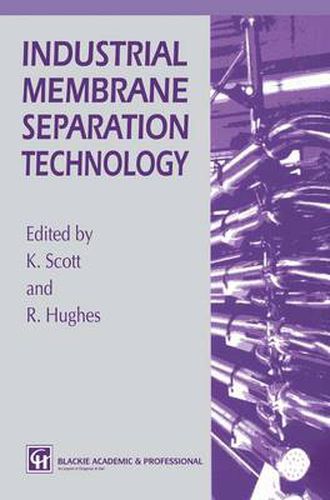Readings Newsletter
Become a Readings Member to make your shopping experience even easier.
Sign in or sign up for free!
You’re not far away from qualifying for FREE standard shipping within Australia
You’ve qualified for FREE standard shipping within Australia
The cart is loading…






This title is printed to order. This book may have been self-published. If so, we cannot guarantee the quality of the content. In the main most books will have gone through the editing process however some may not. We therefore suggest that you be aware of this before ordering this book. If in doubt check either the author or publisher’s details as we are unable to accept any returns unless they are faulty. Please contact us if you have any questions.
Membrane science and technology is an expanding field and has become a prominent part of many activities within the process industries. It is relatively easy to identify the success stories of membranes such as desali nation and microfiltration and to refer to others as developing areas. This, however, does not do justice to the wide field of separations in which membranes are used. No other ‘single’ process offers the same potential and versatility as that of membranes. The word separation classically conjures up a model of removing one component or species from a second component, for example a mass transfer process such as distillation. In the field of synthetic membranes, the terminology ‘separation’ is used in a wider context. A range of separations of the chemical/mass transfer type have developed around the use of membranes including distillation, extraction, absorption, adsorption and stripping, as well as separations of the physical type such as filtration. Synthetic membranes are an integral part of devices for analysis, energy generation and reactors (cells) in the electrochemical industry.
$9.00 standard shipping within Australia
FREE standard shipping within Australia for orders over $100.00
Express & International shipping calculated at checkout
This title is printed to order. This book may have been self-published. If so, we cannot guarantee the quality of the content. In the main most books will have gone through the editing process however some may not. We therefore suggest that you be aware of this before ordering this book. If in doubt check either the author or publisher’s details as we are unable to accept any returns unless they are faulty. Please contact us if you have any questions.
Membrane science and technology is an expanding field and has become a prominent part of many activities within the process industries. It is relatively easy to identify the success stories of membranes such as desali nation and microfiltration and to refer to others as developing areas. This, however, does not do justice to the wide field of separations in which membranes are used. No other ‘single’ process offers the same potential and versatility as that of membranes. The word separation classically conjures up a model of removing one component or species from a second component, for example a mass transfer process such as distillation. In the field of synthetic membranes, the terminology ‘separation’ is used in a wider context. A range of separations of the chemical/mass transfer type have developed around the use of membranes including distillation, extraction, absorption, adsorption and stripping, as well as separations of the physical type such as filtration. Synthetic membranes are an integral part of devices for analysis, energy generation and reactors (cells) in the electrochemical industry.